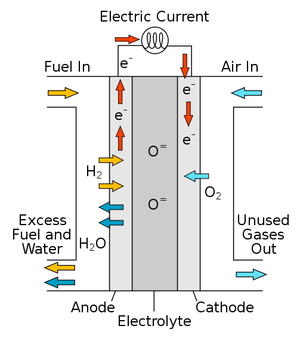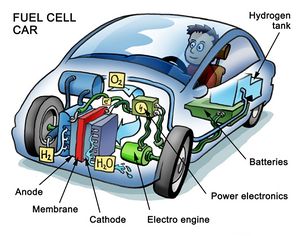Hydrogen as an energy currency


This article refers to hydrogen as a molecule, H2. This molecule isn't produced in nature on Earth and must be made by people in a lab or an industrial facility. Although molecular hydrogen is the most common molecule in the universe, it's hard to tell exactly how much there is.[3] This is distinct from atoms of hydrogen, which occur in great abundance on Earth and elsewhere in the universe.
Hydrogen can be seen as energy currency since it does not naturally occur in its molecular form on Earth, and is made by inputting some energy, see figure 1. This turns it into a secondary fuel (a high density repository of energy that's easier to transport and use). Primary energy is needed to create hydrogen fuel. This energy comes either from burning fossil fuels, using nuclear power (which David S. Scott wrote about extensively),[4] or by using intermittent electricity sources like solar power and wind power. While it may not sound like an efficient use of energy to do this, hydrogen fuel is about ten times more energy dense by volume than Lithium-ion batteries, and more than 100x more energy dense by mass! This means that in the future, if infrastructure changes, many "alternative" sources of primary energy, like wind and solar power, may be used. Then the energy they create can be stored in hydrogen fuel, which is far more efficient than batteries.
While hydrogen is an energy currency rather than a primary energy source, it is still considered to be a fuel (although not a primary energy source). This is because it's a material with a high energy density, making it an easily transportable source of electricity. Hydrogen is used in one of two ways: either in an internal combustion engine (burning it), or by reacting it directly with oxygen in a fuel cell to create electricity and run an electric motor. The former powers rockets, and the latter is how hydrogen-powered cars work, like in Figure 2.
Some authors[4] feel that hydrogen is an inevitable energy currency, while others[5] feel quite strongly otherwise.
For Further reading
- Hydrogen
- Energy currency
- Fuel cell
- Hydrogen-powered car
- Primary energy
- Secondary fuel
- Or explore a random page
References
- ↑ Wikimedia Commons [Online], Available: https://commons.wikimedia.org/wiki/File:Solid_oxide_fuel_cell.svg#/media/File:Solid_oxide_fuel_cell.svg
- ↑ Wikimedia Commons. "Fuelcell" by Welleman, [Online], Available: https://commons.wikimedia.org/wiki/File:Fuelcell.jpg#/media/File:Fuelcell.jpg
- ↑ http://ned.ipac.caltech.edu/level5/Combes3/Combes4.html accessed December 17th, 2014
- ↑ 4.0 4.1 Scott, "Smelling Land," 1st edition, Vancouver, Canada: Canadian Hydrogen Association, 2007
- ↑ McMahon, "Emperor's New Hydrogen Economy" 1st edition, iUniverse, Inc., 2006

